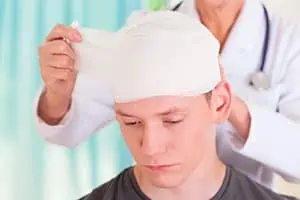Brain Games: Sobering new study finds young athletes in contact sports at risk for degenerative brain disease
November 8, 2023
Written on behalf of Aitken Aitken Cohn

And experts say the benefits far outweigh the risks.
However, it’s important for parents raising young athletes to know the dangers inherent in the games their kids play—especially if they participate in high-contact and collision sports.
This summer, new research from the Boston University CTE Center found degenerative brain disease in a startling number of brain samples from individuals who died before age 30 (ranging from 13 to 29)—many amateur athletes.
CTE—Chronic Traumatic Encephalopathy—is an Alzheimer ‘s-like disease associated with repeated head injuries, including concussion/TBI and blows to the head. According to the Mayo Clinic, CTE causes “the death of nerve cells in the brain, known as degeneration.” While the condition is progressive and fatal, the only way to formally diagnose it is through an autopsy of the brain.
The BU study, published in JAMA Neurology, examined 152 brains donated to the UNITE Brain Bank between February 2008 and September 2022. The brains in the study were explicitly donated because, before death, the person had shown symptoms of CTE, including confusion, memory loss, aggression, trouble with impulse control, impaired judgment, depression, and suicidal behaviors.
Examining the brains, researchers found a build-up of a tau protein that can “disable neuropathways,” CNN reported. Researchers found the most significant damage to the brain around the frontal lobe, which helps manage attention, judgment, and executive function and may contribute to impulse control. They also found structural changes to the brain, such as a split membrane between the two halves and evidence of atrophy.
As CTE relates to sports, the findings were remarkable:
- Over 40% of the brains of young athletes involved in contact/collision sports had CTE. (For context, in brains from the broader population, less than 1% show signs of CTE).
- Of the study’s total brains diagnosed with the disease, 71.4% came from amateur athletes.
- The athletes in the study had primarily played high-contact sports, including football (60%), soccer (15%), and ice hockey (10%), as well as wrestling and rugby.
- Of 48 football players, 37 were amateur, and 11 were from the NFL.
- In this study, a 17-year-old high school football player was the youngest person found to have CTE.
- The study included only 11 brains from females but resulted in one positive diagnosis of CTE in a female former athlete, an unidentified 28-year-old college soccer player. Due to a lack of data, it is still unclear whether the disease is more common among males than females.
- 87 of the 152 individuals whose brains were studied had died by suicide, the most common cause of death, followed by unintentional overdose. (It is important to note, however, that in the brains studied, this was true of both groups—”Neuropsychological symptoms were severe in both those with and without evidence of CTE,” the NIH explains.)
The study is particularly notable because past research in CTE has focused on former professional American football players—older adults who may have had long careers and/or show age-related neurodegenerative brain disease. (In a study released by BU CTE Center earlier this year, 92% of 376 former NFL players were diagnosed with CTE). Military veterans also suffer from CTE after exposure to bombs and blasts.
By contrast, most of the athletes in the recent study had played youth, high school, or college sports. This under-30 age group offers a crucial viewpoint: the results showed that, even at a young age, the longer the person had played the sport, the more likely they were to develop the disease. According to Ann McKee, director of the BU CTE Center, football players double their risk every 2.6 years in the sport.
In BU’s report on the study, McKee said, “It seems to be well accepted now that you can play at a very high level of elite American football or ice hockey and get CTE…. but we’re seeing the beginnings of this disease in young people who were primarily playing amateur sports.”
McKee has helped develop protocols for harm reduction in contact sports and advocates for specific rule changes.
According to the report, McKee’s team’s latest study highlights “a pattern of depression and behavior issues,” indicating young athletes “need broader support when it comes to their physical and mental health.”
“If a person is experiencing symptoms, says McKee, “they need to seek help because it’s highly probable that a lot of these symptoms can be managed.” While team sports offer kids enjoyment and health benefits, coaches, schools, organizations, and parents need to understand the brain risks involved in high-contact games so they can recognize and take early CTE symptoms seriously.
AAC’s extensive track record in successfully litigating traumatic brain injury cases includes a remarkable $23 million jury verdict on behalf of a 13-year-old boy who sustained severe brain damage in a car collision, a groundbreaking $20 million settlement (with an estimated payout of over $100,000,000) for an 8-year-old boy who suffered a brain injury after falling from a soft-contained playground at a prominent fast- food chain and resolving Ryan Corbin’s traumatic brain injury case for more than $10 million.
AAC’s personal injury attorneys recently obtained a $11.5 million settlement against Riverside University Health System – Medical Center on behalf of a woman who sustained an anoxic brain injury when the defendant anesthesiologist negligently intubated her during a routine surgery to remove a breast lump.
A victim of a traumatic brain injury not only faces tremendous physical challenges but psychological ones as well. Brain injury victims must seek legal representation and consult with a lawyer with experience with brain injuries. The Riverside brain injury lawyers at Aitken * Aitken * Cohn have assisted countless clients in achieving extremely successful legal results.

